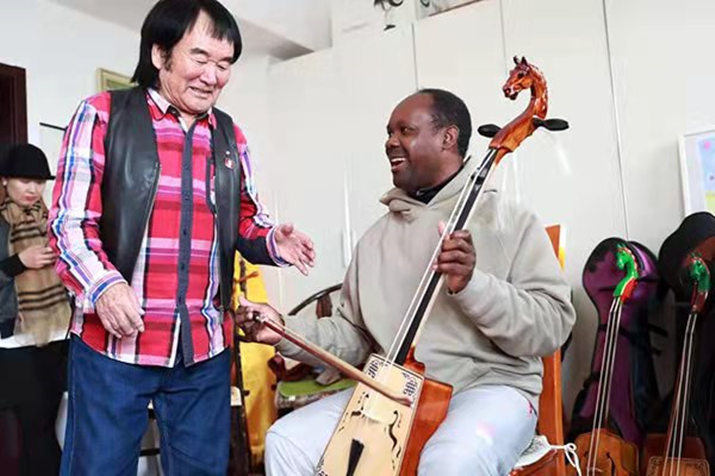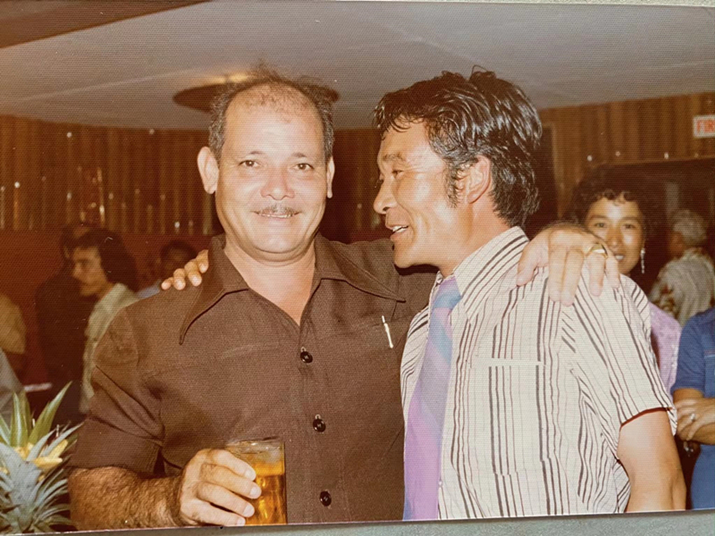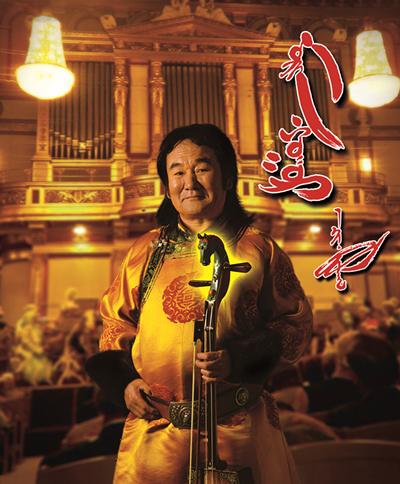In tune with the horse

Chi Bolag teaches his only African disciple Luc Bendza the art of the morin khuur on 8 January 2022 in Beijing
Luc Bendza, a well-known Gabonese martial artist and actor who has appeared in numerous films and television shows in China, never imagined he would fall in love with another Chinese art at the age of 53. But in early 2022, after hearing an elderly morin khuur (also known as a horse-head fiddle) musician playing a tuneful piece of music, he made the decision to learn how to play the Inner Mongolian instrument from the player.
The player is none other than Chi Bolag, director of the Chinese Morin Khuur Society. He is the one who introduced the horse-head fiddle’s traditional music to an international audience.
Modernisation of the traditional art
An orchestra of 120 morin khuur players performed a piece titled Ten Thousand Horses Galloping on 8 August 2008 at the opening ceremony of the Beijing Olympic Summer Games to an awestruck international audience.
The enchanting tunes gave the spectators the impression that they were galloping through a large piece of grassland on horses. The orchestra’s lead musician was Chi.
The morin khuur could only be played solo when Chi began to learn this traditional art more than 60 years ago. In 1986, in a letter submitted to the local government, Chi suggested that morin khuur players be grouped together within Inner Mongolia Autonomous Region. He believed that a group of excellent instrumentalists might breathe new life into this ancient music. The suggestion was accepted. A few months later, the world’s first morin khuur group was formed under Chi’s leadership.
The ensemble debuted at a gala event honouring the Inner Mongolia Autonomous Region’s 40th anniversary in 1987. The players’ concerted efforts created a huge sensation. The audience was overwhelmed by the grandeur and great intensity of this ethnic music. Some people even remarked that the ensemble had the sound of a herd of wild horses galloping over the grassland. Since then, the group is known as “Wild Horses.”
Chi has developed a number of new technologies for the morin khuur in addition to being a master player. He studied the violin for four years, extending the morin khuur’s artistic potential with the bowing and fingering of the Western instrument. In addition, he has successively used snake skin and white pine for cattle skin on the morin khuur, so that it can have an even more exquisite timbre in concert.

Chi Bolag developed a deep bond of friendship with the local people during his tour to Africa in 1978
Legacy of a rich heritage
Chi has organised more than 100 concerts throughout the world over the years, including one in Vienna, Austria, to introduce this art form to a global audience. In the Golden Hall of the Musikverein, he and his Wild Horses group enchanted the audience in 2005 at a celebration of the 60th anniversary of the victory in World War II. “Our ancestors came here with horses and broadswords about 760 years ago. Today, the descendants of Genghis Khan have returned with horse-head fiddles. We are here for peace and we are messengers of peace,” he declared to the European audience.
In 2008, UNESCO listed the folk music of the morin khuur as an intangible cultural heritage of humanity. As the national heir, Chi has spared no effort to better perpetuate this ancient Chinese art.
In 2011, with the support of the local government, the world’s first horse-head fiddle academy was established in Xilinhot, Inner Mongolia, with Chi as its head. Ten years later, another public music school bearing his name was set up in Erdos to train morin khuur players. In total, he has over 50,000 disciples from all over the world.
Bendza is the sole African among them. In fact, Chi had been hoping to have an African apprentice for 50 years. Chi travelled to Burundi, Tanzania, and the Seychelles in 1978 as part of an art delegation from Inner Mongolia. He stayed in the continent for about two months. This is his only trip to Africa in his lengthy career. By integrating Bendza into his ranks, he hopes to renew the ties of friendship he has forged with African local people. The martial master also claims he wants to practice with Chi in order to one day spread this art form across Africa.

About the Morin Khuur
In Mongolian nomadic culture, the morin khuur, a two-stringed fiddle, is highly valued. The significance of the fiddle goes far beyond its use as a musical instrument because it used to be an essential component of Mongolian nomadic rites and daily life. The cult of the horse, which is highly revered by Mongolian people, is directly related to the distinctive design of the morin khuur.
The instrument’s trapezoidal-shaped hollow body features a long neck without frets and a horse’s head at the end. On either side of the neck, two pegs that resemble ears emerge just below the skull. Horsehair is used for the strings and bow, while animal leather covers the sound box. The characteristic sound of the instrument is produced by rubbing or striking the bow against the two strings. One of the most common playing techniques is the right hand bow pull and push, with various left hand fingerings. It is often played solo, but can also be used to accompany dances, long songs, mythical stories, ceremonies and daily tasks involving horses. To this day, the morin khuur repertoire has retained a few tunes specifically for taming animals.

